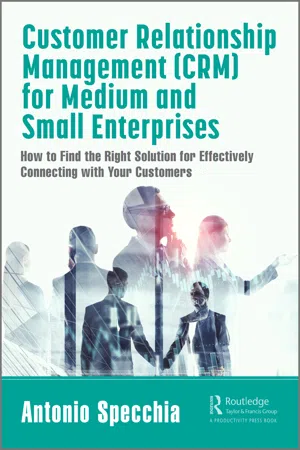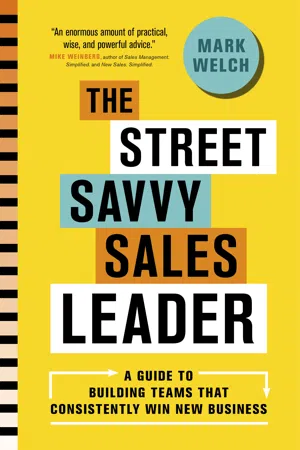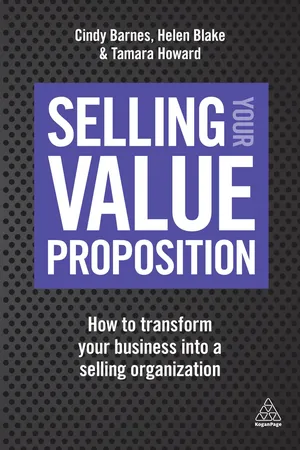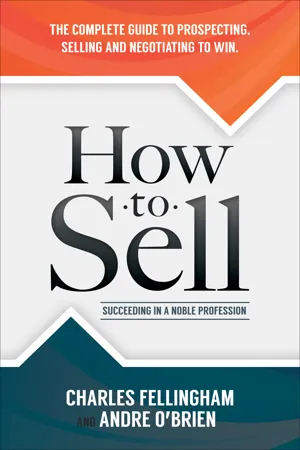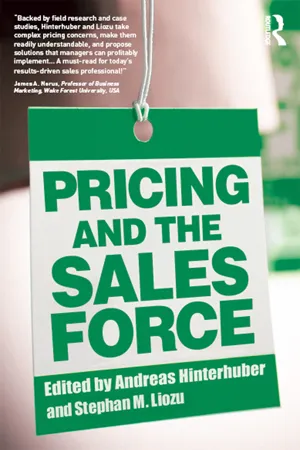Business
Stages of Sales Process
The stages of the sales process typically include prospecting, initial contact, needs assessment, presentation, handling objections, closing the sale, and follow-up. These stages guide sales professionals through the process of identifying potential customers, understanding their needs, and ultimately converting leads into sales. Each stage requires specific skills and strategies to effectively move prospects through the sales funnel.
Written by Perlego with AI-assistance
Related key terms
Related key terms
1 of 4
Related key terms
1 of 3
8 Key excerpts on "Stages of Sales Process"
- eBook - ePub
Customer Relationship Management (CRM) for Medium and Small Enterprises
How to Find the Right Solution for Effectively Connecting with Your Customers
- Antonio Specchia(Author)
- 2022(Publication Date)
- Productivity Press(Publisher)
They just tend to take for granted what the salespeople should be doing. Most probably they know how they work and what they are expected to do, especially sales directors, but if you ask them to write it down, they might trip. It is mainly a lack of formalisation, not a lack of know-how. Thus enquiring of them in a proper way enables us to unveil the sequence of actions that shape the interaction process with prospects, the journey each prospect generally takes from the stage of unawareness to the purchasing act, or just up to the point when the prospect decides to quit.To structure it under a simple approach, we can divide the process into stages; at each stage, certain actions are expected and they should provide an output.Stages are in sequence as ideally the journey will have a starting point -the entrance into the process-, then some steps to be performed before reaching an end where prospects will exit the process for better or for worse. Obviously, in a figurative journey people can jump stages getting different shortcuts, or take longer to get accustomed to the process. Designing the sales process means defining those stages in a way that depicts what is expected to be done in each of them and what outcome is expected.Sales Process Stages
In many cases, the use of sales stages is merely a static naming convention, including, for instance, “Contact Made,” “Proposal Sent,” or “Negotiation.” We argue that naming each stage in a more dynamic way exerts an effect on people who have to act accordingly. The idea is not to create a repository for deals and opportunities once “contact has been made,” but to constantly remind to salespeople what is expected to be done. This technique applies a strong driver to what is to be done well beyond the simple silos of stages to be filled of contacts data, but more as a dynamic workflow that salespeople run by each single action. Actions that are well described in each stage naming. - eBook - ePub
The Street-Savvy Sales Leader
A Guide to Building Teams that Consistently Win New Business
- Mark Welch(Author)
- 2018(Publication Date)
- Figure 1 Publishing(Publisher)
5There is also, depending on your organization, the potential to have more than one sales process. You may have one for new customer acquisition versus account management and share of wallet (SOW ) growth. You may have modified sales processes for different markets or industries you sell into and even a different process for different applications or solutions you sell.Stages of the Sales Process
There is a lot of room to customize the sales process to fit how Sales is organized, the industry you’re in and your target market. The better aligned the sales process is to the buying process, the more relevant the sales discussions and reviews will be and the more accurate the forecast outcome should be. The goal of each stage is to take a potential opportunity to the next stage until the business is closed. Figure 5.1 illustrates a generic and widely used example of the sales process.Figure 5.1: The Sales ProcessLinda Richardson, in her book Changing the Sales Conversation , describes the essence of the sales process very well: “An effective sales process is very specific, defining:- the major stages in the sales cycle;
- objectives to accomplish in each stage;
- selling activities to carry out in each stage based on best practices;
- verifiable outcomes to spell out actions that clients must take to signal their readiness to move to the next stage;
- sales tools to support your sales efforts at each stage; and
- dialogue models to help you deliver your message clearly.”6
It is advantageous to work with Marketing on this process to facilitate a consistent and robust funnel that the business can use to react in real time to developments and opportunities in the market. The actual details of the process will vary by target market—for example, small business, mid-market, enterprise and government markets—as well as the channel. - eBook - ePub
Sales Is a Team Sport
Aligning the Players with the Playbook
- John Fuggles(Author)
- 2022(Publication Date)
- Business Expert Press(Publisher)
The Sales Process is one part of a system. It has component parts such as the Sales Funnel, the Pipeline, and works in parallel with CRM systems or perhaps Opportunity Tracking Systems (OTS) and then has wrapped around its skills, tools, techniques, data, products, and, of course, people. When all is considered, a Sales Process is not so much a fast jet rather a load of nuts and bolts flying in close formation. It may not always be joined up, but these individual parts do seem to serve a common purpose and work together.According to Customer Centric Selling, the sales process is “a defined set of repeatable, interrelated activities from market awareness through servicing customers that allows communication progress to date to others within the company.”Diagrams of a sales process are either a linear chart or a circle. Accepting it is a process, the cyclical design makes more sense. What is often drawn is not so much the process but the hub of an altogether more complex series of processes and procedures leading to projects. Even before the process starts, there is work to be done. In much the same way that games are often won and lost long before the team gets on the pitch. But let us start with the basics.Some leads will be new and may have been acquired, they called you or you called them—“cold calling”—to qualify them as a potential customer. Other leads will be of or from existing accounts or from existing contacts. So, let us start there.Existing CustomersExisting customers we should also include lapsed customers and long-standing contacts or companies that have never been customers. Accepted they are not customers but the journey to make them a customer begins at the same point.A company that already buys a product or service from you is a great place to start. We can sell them more stuff (one of my all-time favorite words) and, if we do not have anything new to sell them, we can always find a way to expand our portfolio or develop additional offerings that may appeal. - eBook - ePub
Selling Your Value Proposition
How to Transform Your Business into a Selling Organization
- Cindy Barnes, Helen Blake, Tamara Howard(Authors)
- 2017(Publication Date)
- Kogan Page(Publisher)
05The sales process
Many readers of this book will be familiar with the sales process, the sales cycle and the different types of selling. If you are one of these readers, we would suggest you skip this chapter and move on to read about sales storytelling in Chapter 6 , a summary of our Laws of Value Proposition Selling in Chapter 7 , or ‘Creating the selling organization’ in Chapter 8 .If, on the other hand, you are relatively new to the nuances of selling, you may find this chapter useful. In order to properly exploit your sales proposition it is important to understand each stage of the sales cycle from both the salesperson’s and the customer’s perspective.Stages of the sales process
A quick review of the standard sales process shows what is happening at each stage:- to progress the sale;
- to show what is going on in the mind of the customer;
- and to illustrate the different activities of the two sales types mentioned so far.
The circular diagram in Figure 5.1 illustrates the process for any type of sales opportunity and for all types of sales approaches. In large organizations many of these processes may be occurring simultaneously as different sales opportunities arise and customer needs are met. For new customers, the first sales engagement may start as early as the ‘suspect’ stage.Figure 5.1 The eight steps of the sales processThe eight steps of the sales processSOURCE Verve Consulting, 2016Many organizations use these terms loosely without consideration for what each means in terms of what is going on in a prospective customer’s mind and what a salesperson should be doing. This process is appropriate for any - eBook - ePub
How to Sell
Succeeding in a Noble Profession: The Complete Guide to Prospecting, Selling and Negotiating to Win
- Charles Fellingham, Andre O'Brien(Authors)
- 2016(Publication Date)
- Morgan James Publishing(Publisher)
CHAPTER 3
The Sales Process
W hy do we need a process? We believe that salespeople like a process and have a desire to know the step they are in during the evolution of the sale. Following our sales process will keep you organized, will help you think before you speak, and drive you towards the commitment phase with structured confidence.W. Edwards Deming, the father of modern quality, once explained why products fail13 . It is caused by variation in the product’s manufacturing, materials, use or maintenance processes. A whole quality movement was built around that very thought and still survives today. This movement demands great effort to reduce or eliminate variation in each step of manufacturing. For every successful product or service, there is a refined, uniform process followed and executed with consistent precision. This also could be true for salespeople who want to match their valued solutions to business needs.We have constructed a sales process to help you understand the simple steps to advance your sales conversations and opportunities. The process flows from one step to the next and each element builds on the next. These steps show the natural progression used to build most business relationships. They are:1. Build a Bond – connect, build trust, promote cooperation.2. Explore the Gap – Be curious, be a consultant, explore needs.3. Build a Bridge – Reveal buying motive.4. Bridge the Gap – summarize needs, present your solution.5. Walk the Bridge – handle objections, motivate the sale.6. Close the Gap – get their commitment.In this chapter we will expand on each element of the sales process.STEP 1: BUILD A BOND
This step is essential to any sales process. We do not sell in a vacuum. We need information to effectively sell and thus we need the prospect's cooperation to obtain the details we will use to construct a solution. We must consult before we construct our solution. And we must connect before we consult. - eBook - ePub
Medical Sales Professional
Selling into the Global Healthcare Markets
- Roy Layfield PhD(Author)
- 2021(Publication Date)
- Austin Macauley Publishers(Publisher)
The Basic Sales Process
Selling is a technique that none of us are born with. Some people, however, are naturally adept at this whilst the rest of us have to consciously learn, and apply, the necessary skills. Regardless of where you sit in this equation, the basic sales process remains the same. Those who apply it without thinking, do exactly the same thing as those who think about every single step. Over time, it’s easy for even the most inexperienced salesperson to become the very best, simply by applying these steps in the right order, and being strategic about their approach.Briefly, it begins with the building of rapport, followed by establishing the customer’s need – a process that often involves creating that need until they can see it for themselves. This step uses lots of probing or questioning (without turning the call into an interrogation), and is followed immediately by the actual selling step of meeting their needs with your product or service. At this point, the customer may have some legitimate concerns or raise objections, and as you successfully address each of these, you can move toward the final and most important step of all, i.e. closing the call and asking for the sale. In its simplest form, that is how you sell any product to any customer , and it works perfectly.Of course, that’s a very simplistic overview of just what’s involved, and to use these techniques effectively then you need to know far more about utilising each step to its best potential. In this chapter, I’ll break each of them down for you, i.e.- Building rapport
- Establishing the need
- Meeting the need
- Handling objections
- Closing the sale
The detailing process itself is quite a soft sell - eBook - ePub
The Smart Start Up
Fundamental Strategies for Beating the Odds When Starting a Business
- Tom Hopkins, Omar Periu(Authors)
- 2018(Publication Date)
- Morgan James Publishing(Publisher)
“I want to buy this.” On the other side of the equation, few people you hire will have a solid enough understanding of the sales process to just start selling for you with little or no help. They need training.Until you reach a point where you can hire a sales manager or in-house trainer, the responsibility for training will fall to you—or at least it’ll be your call on using any outside services for training.There are thousands of nuances that make up the art and science of selling. No one book could possibly cover them all. However, we’ll do our best in the rest of this chapter to get you started on the path to sales success.The seven steps of the sales process include:- 1. Prospecting – where and how to find new potential clients
- 2. Initial Contact – making direct contact with those potential clients
- 3. Qualification – determining whether your potential clients have the need, interest and ability to become satisfied clients
- 4. Presentation or Demonstration – employing strategies to help your potential clients envision themselves owning the benefits of your product
- 5. Addressing Concerns – helping people overcome the natural fears that arise when making buying decisions
- 6. Closing Sales – using effective strategies to clearly and directly ask for the business and get a commitment
- 7. Getting Referrals – how to get your clients to refer you to others
Prospecting
Where are your clients going to come from? There’s an old saying, “Build a better mousetrap and the world will beat a path to your door.” Sounds wonderful, doesn’t it? The only way you’ll get the world to beat a path to your door is to build the path, and then tell the world where it is—not just what it leads to.As a solo entrepreneur or small business owner, you’ll want to quickly learn strategies to generate leads for business. One of the simplest strategies is called the Three-Foot Rule . How it works is that you speak with anyone who comes within three feet of you to determine one of two things:- 1. Are they a potential candidate for your product?
- 2. Do they know someone who is a potential candidate for your product?
- eBook - ePub
- Andreas Hinterhuber, Stephan Liozu(Authors)
- 2015(Publication Date)
- Routledge(Publisher)
sales process and execution layer addresses how a company sells to its customers, in other words, how that sales work is being delivered. As the sales effectiveness framework clearly defines, sales execution is just one part of a successful sales organization. The framework creates a systemic and strategic view of how much sales performance depends on the delivery of sales work, or selling, and how much sales performance depends on strategy, management, and support functions.The framework describes a single, generic sales process. Different industries and companies have their own, specific sales processes. The sales process illustrated is a customer-validated sales process; that is, each step requires verification by more than one person at the customer level to ensure alignment between sellers’ and buyers’ organizations. IBM is considered a leader in designing customer-validated sales processes. Sales processes in general are about efficiency and the coordinated use of resources. Ineffective sales processes are a potential source of competitive advantages. Therefore, I discuss the sales process as generically level rather than addressing specific steps of the process. Aligning pricing and the sales process is essential when it comes to customer-facing sales work.- The beginning of the sales process—initial customer meetings—sets many expectations for customers, explicitly as well as implicitly. Perceived price level is often communicated only indirectly, through customer case studies, references, and so on. Therefore, training and coaching of salespeople into the discipline of price communication is vital. The sales force needs to find a systematic approach to setting expectations in a humble and subtle fashion. They must also be able to learn about customer value in the early phases of the sales process. Understanding the customer’s business case and customer value is an important part of opportunity qualification. If a salesperson cannot define how valuable the offering is to the customer, it is difficult to win, let alone profitably win.
Index pages curate the most relevant extracts from our library of academic textbooks. They’ve been created using an in-house natural language model (NLM), each adding context and meaning to key research topics.
Explore more topic indexes
Explore more topic indexes
1 of 6
Explore more topic indexes
1 of 4
